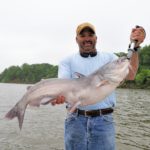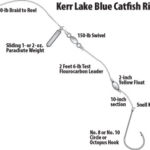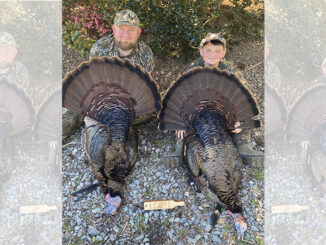
Reservoir that produced world-record blue is still spitting out huge catfish
John H. Kerr Reservoir’s fishing reputation once was as a top destination for largemouth bass and striped bass, but those days have disappeared.
An infestation of copepods, aka gill maggots, killed most of the lake’s big stripers, and Largemouth Bass Virus reduced the bass population substantially.
Those diseases left catfish as the major summer fishing target on Kerr Lake, aka Buggs Island, and the 58,5000-acre reservoir holds plenty of large specimens. In fact, Nick Anderson, a high-school football coach from Greenville, landed the current world-record blue catfish, a 143-pound giant, on June 18, 2011, in the lake’s upper reaches near where the Dan and Staunton rivers converge.
Van Hughes, 47, of Stem, guides for blue catfish on Kerr, and he said July is a great time to catch blues and flathead catfish — although fishermen can catch them just about year-round.
“I started fishing for catfish at Buggs Island with my father and brother when I was five years old,” said Hughes, an Oxford native. “Sometimes we make double trips, starting at noon and fishing until 4:30 p.m. for blue cats, then we fish for flatheads after dark.
“What we go for depends on what our customers want, but I have to say blue cats are so strong, after a half-day fighting them, most people pass on night fishing. The ones who go for flatheads at night mostly prefer their taste over blue cats. I fish more for blues because it’s easier to get bait for them.”
Hughes usually catches several dozen crappie the day before a catfish trip, and then places them and keeps them alive in a 200-gallon baitwell at his house.
“Blues like to eat crappie filets and crappie heads, so I’ll take three or four dozen crappie, put them in a cooler and ice them down,” he said. “Later, on my boat, I filet them and put them on the hooks.”
Hughes always scales the filets before using them as bait.
“Blue cats would rather eat scaled filets,” said Hughes, who also uses shad or white perch as bait. “Sometimes I’ll scale and filet a crappie, remove the backbone and tail and leave the filets attached to the head. That way the fillets fluter in the water. Catfish find baits not only by smell, but by vibration.”
He employs two methods of fishing for blue catfish — drifting slowly with the wind or using a trolling motor. He anchors at night to fish for flatheads.
Drifting or trolling serves the same purpose. The ideal drifting speed for blue catfish is .4 to .5 mph, barely moving baits across the bottom. When it’s blustery, the wind can push his boat too fast; in that case he uses a drift sock to slow his boat’s speed.
A drift sock is basically a collapsible plastic parachute about three feet in diameter tied to a rope that’s tied to a rod-holder frame near the center of his boat. Tossed over the windward side of his 19-foot center-console, the drift sock’s drag in the water holds Hughes’ boat speed down to an acceptable pace.
“The wind can blow 25 mph, and the sock only will let the boat move about 1 mph,” he said.
If there’s no wind, or its direction doesn’t allow Hughes to drift an area the way he wants to, he drops his trolling motor to pull baits across catfish haunts he’s known about for years.
“If I’m drifting, I put eight rods out on one side of the boat,” said Hughes, who along with partner Todd Swain of Winston-Salem has learned the tricks of the trade by fishing catfish tournaments from North Carolina to Kentucky to Alabama. “If I troll, I put six or eight rods off the stern.”
Hughes’ terminal tackle set-up is similar to the famed “Santee rigs.” He always employs them in the Dan River section of the Kerr Lake north of Clarksville, Va., where most of the lake’s big catfish have been landed.
He uses 80-pound PowerPro braid for his main line, tied to three feet of 60-pound fluorocarbon leader. Above his leader swivel, he attaches a “bottom bouncer,” basically a parachute-cord weight with an ounce or two of inside; the depth he’s fishing determines the size. The weight bounces off the bottom but crawls over obstructions and reduces hang-ups. About eight to 10 inches in front of a 10/-0 circle or octopus hook, he clips on a 2-inch long cork that helps keep hooks and baits just off the bottom.
“We do lose rigs to hang-ups, but we make our own bottom-bouncers for 50 cents each, so it’s not so expensive,” said Hughes, who outfits medium-heavy 7-foot-10 Surge catfish rods fitted with Ambassadeur 7000 level-wind bait-casting reels.
Hughes hunts big July catfish at two places — north of Clarksville where the world-record blue cat was landed, or in deeper water east toward the Kerr Lake Dam.
“In July, blue cats tend to hold near structure in 15 to 40 feet of water,” he said. “They’ll either be on the bottom or suspended over tree tops. A lot of people who fish for them don’t know about the tree tops.”
A key piece of equipment is a quality fish-finder with a screen that will display structure, baitfish and catfish.
“In the summer the depth-finder shows catfish in the tops of trees,” Hughes said. “They like to hold there because baitfish also will get in that structure. I’ll pull baits just across the tops of the trees.
“Where the Dan and the Staunton river channels come to a head and meet near a point stacks up baitfish,” Hughes said. “It’s where the world-record (blue catfish) was caught.”
The best wind direction for a drift between that area down the lake to Clarksville is southeast to northwest.
“There are old river channels, structure and humps offshore a couple hundred yards that run parallel to the shore,” Hughes said. “When we drop baits and drift through there, it usually will put a filet in front of a catfish’s nose.”
He expects a bite along the channel drops. Blue catfish and baitfish hold on these ledges, especially if there are rocks, stumps or trees on the bottom that provide cover.
Hughes caught his largest blue catfish — “It weighed between 75 and 80 pounds,” he said —in that area,.
Many of his summer clients want smaller fish to take home catfish to eat.
“What sizes we catch depend on the bait chunks,” Hughes said. “Smaller pieces of cut bait and smaller hooks catch smaller fish, while the big baits — a whole fillet or a crappie’s head with a big hook — will land larger catfish. The little catfish will try to eat bigger baits, but you’ll mostly just see the rod tip bouncing because they can’t get the big baits in their mouths.”
Hughes’ technique for hooking catfish is to watch a rod tip for a steady pull toward the water. He turns the reel handle until he feels tension, then lifts the rod out of its holder and makes a quick hookset. If a big catfish has the bait, he’s usually hooked.
“You can tell when a really big catfish hits because it will slam a rod down hard, sometimes against the side of the boat,” Hughes said.
As good as Kerr Lake is for catfish, Hughes said the overall size of fish has declined.
“Once, you could catch a 20-pounder anywhere on the lake. That’s not true any more,” said Hughes, who blames “noodle” fishing — where fishermen fish baits under numerous floats.
“A lot of people come to Buggs Island to get catfish to eat,” he said. “Many, many catfish have been taken out of the lake by noodlers.”
Moreover, high water one recent spring during the flathead spawning period contributed to their decline, he said.
“The water pushed behind one of the dams at Danville (Va.)and trapped thousands of flatheads,” he said. “People took ’em out of there by the truckloads, and it really hurt their numbers in the lake.”
Fishermen are permitted 20 catfish per day at Kerr Lake in its Virginia waters, but only one blue catfish longer than 32 inches in length. No creel or size restrictions exist for catfish on the North Carolina side of the lake. The two states do recognize and accept fishing licenses from either state, anywhere on the lake.
DESTINATION INFORMATION
WHEN TO GO/HOW TO GET THERE/ — July through September are the best months to catch a big blue or flathead catfish at Kerr Lake. Take I-85 north toward Virginia. You can take NC 15 north from Oxford to Clarksville, Va., or continue to Henderson and take NC 39 north and put in on Nutbush Creek on the lower end. Public ramps are all around the lake; for locations, visit www.kerrlakeguide.com/boat-ramps-camping-picnic-areas.
TACKLE/TECHNIQUES — Medium-heavy 7-foot-10 baitcasting rods with reels spooled with 80-pound braid line and at least two feet of 60-pound fluorocarbon leader are typical. Terminal tackle includes a modified Santee rig with a 1- to 2-ounce parachute cord weight and an 8/0 to 10/0 circle or octopus hook. A drift sock will slow a boat’s movement during windy conditions. Blue catfish prefer cut bait, usually scaled crappie filets, white perch filets or gizzard shad. Flathead catfish prefer live bait, including bream, crappie or shad. Crappie, bream and white perch to be used as catfish bait must be caught with hook and line.
GUIDES/FISHING INFO — Van Hughes, Kerr Crappie and Cats Guide Service, 919-482-3934;. Rose Gin Bait & Tackle, Henderson, 252-438-5656. See also Guides & Charters in Classifieds.
ACCOMMODATIONS — Henderson-Vance Tourism Department, Henderson, 866-438-4565 or www.kerrlake-nc.com. Twenty-nine public campgrounds are scattered around Kerr Lake’s shoreline. For a list, visit http://northcarolinastateparks.reserveamerica.com/camping/Kerr_Lake_State_Recreation_Area/r/campgroundDetails.do?contractCode=NC&parkId=552904.
MAPS — Fishing Hot Spots, 800-ALL-MAPS or http://www.fishinghotspots.com/; GMCO Maps, 888-420-6277 or www.gmcomaps.com; U.S. Army Corps of Engineers, Boydton, Va., 434-738-6143.









